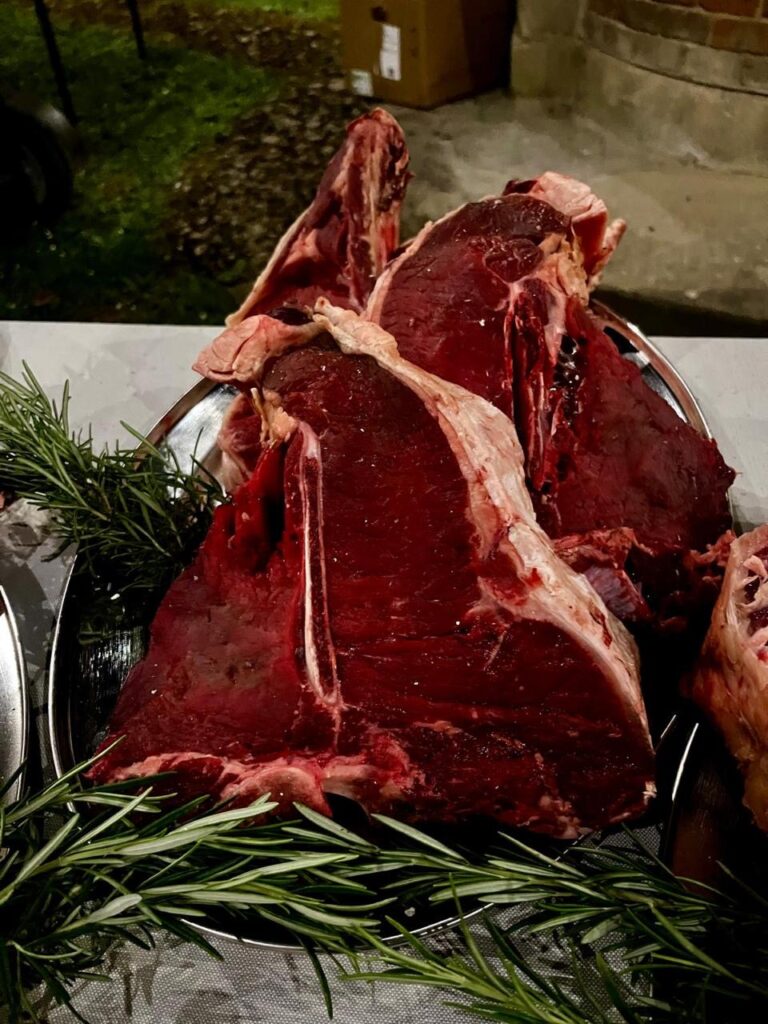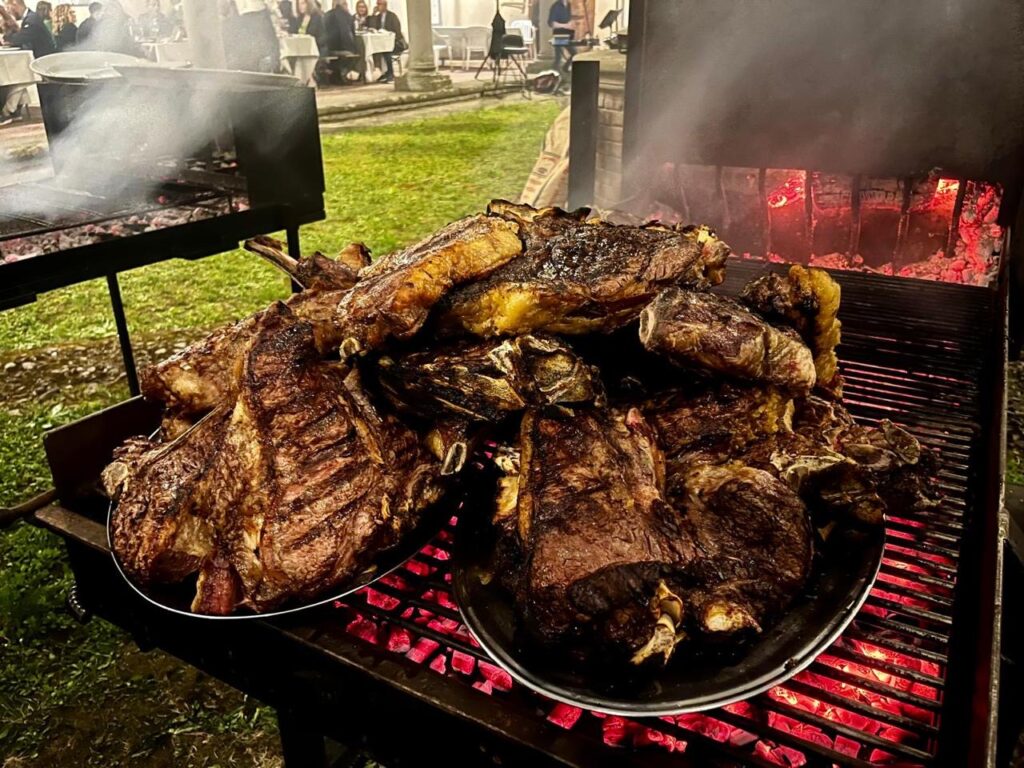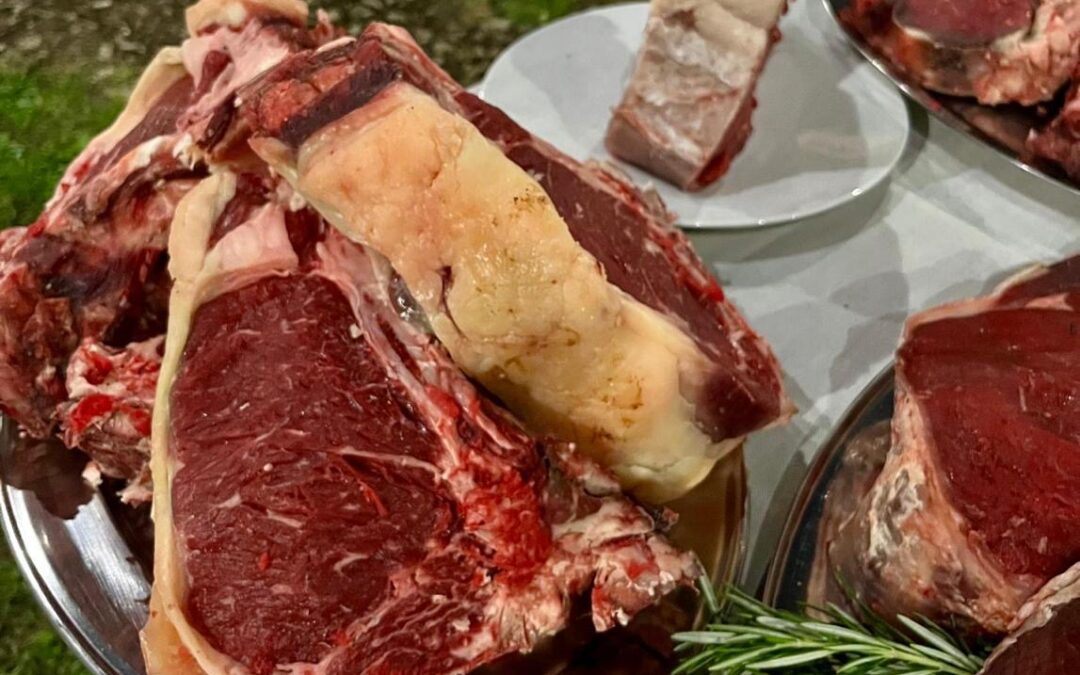Discovering the Majestic Chianina: Tuscany’s Culinary Treasure
Every year in Cortona Ferragosto takes place. This year it is on the 15th of August. It is the best festival in Tuscany and has been going since 1959 when Tonino Restaurant started it. It features the largest working grill in Italy with a 14-metre circumference, heat of 850 degrees, and more than 3000 steaks cooked by 30 people. So come and stay at Palazzo Passerini, live like a local and enjoy a menu of beefsteak (from certified Italian farms), beans, tomatoes, bread, wine fruit and take part in one of the best experiences of your life!
In the rolling hills of Tuscany, the Chianina, a remarkable breed of cattle, has been a symbol of strength and heritage for millennia; recognised as one of the world’s largest and oldest cattle breeds, the Chianina’s pure white coat and statuesque form are a testament to its noble lineage. Originally revered for its power as a draught animal, the Chianina is now celebrated primarily for its exquisite beef, a staple in Italian cuisine and the star of the iconic bistecca alla Fiorentina.
A Taste of History: The Chianina’s Roots
Hailing from the picturesque Val di Chiana, this ancient breed thrives in the fertile lands of Tuscany, Umbria, and Lazio. Its tapered legs, designed for effortless grazing, contribute to the high-quality meat it produces. The Chianina’s diet, consisting of herbaceous forage and preservative-free food, ensures its beef is both succulent and nutritious.
The Pride of Tuscan Cuisine
The Chianina’s meat is the crown jewel of Italian beef, renowned for its tenderness, leanness, and rich flavour. The Florentine steak, or bistecca alla Fiorentina, is perhaps the most famous cut. It is traditionally prepared to be savoured rare, though medium-rare and well-done options are also appreciated. From the prized sirloin to the flavorful rump, the Chianina offers a variety of cuts, each promising a delectable culinary experience.
An Enduring Legacy

The Chianina’s story is intertwined with Italy’s history. The Etruscans and Romans once used these magnificent animals in ceremonial processions and religious sacrifices, adorned with plaits and bows—a tradition that endures today. The breed’s resilience is also notable; during the 17th and 18th centuries, only the hardiest Chianina survived the malaria-ridden plains of Valdichiana, resulting in a robust and healthy cattle lineage.
Modern Farming and Sustainable Practices
Today, the Chianina is primarily raised in Arezzo, where over 6,000 head of cattle graze across the plains of Valdichiana and the verdant hills of Casentino and Valtiberina. Modern farming practices, introduced in the 1960s, have shifted the focus from draught work to the exclusive production of high-quality meat. These cattle, raised in clean air and on lush pastures, embody sustainable farming.
A Culinary Journey
 Beyond the classic Florentine steak, Chianina beef graces numerous traditional Italian dishes. Whether enjoyed in a hearty spezzatino (stew), a flavourful ossobuco (braised veal shanks), or a simple yet delicious trippa (tripe), Chianina’s meat remains a cherished component of regional cuisine. Each dish highlights the breed’s tender, juicy beef, offering an authentic taste of Tuscany’s culinary heritage.
Beyond the classic Florentine steak, Chianina beef graces numerous traditional Italian dishes. Whether enjoyed in a hearty spezzatino (stew), a flavourful ossobuco (braised veal shanks), or a simple yet delicious trippa (tripe), Chianina’s meat remains a cherished component of regional cuisine. Each dish highlights the breed’s tender, juicy beef, offering an authentic taste of Tuscany’s culinary heritage.
The White Veal of Central Appenines
Grouped with the Romagnola and Marchigiana breeds under the appellation ‘Vitellone Bianco dell’Appennino Centrale,’ the Chianina stands out for its historical significance and gastronomic excellence. Its evolution from a symbol of agricultural prowess to a gourmet delight reflects the rich farming traditions and the timeless appeal of Italian cuisine.
Indulging in Chianina beef is not merely a culinary experience; it’s a journey through history, culture, and the pastoral landscapes of Tuscany. The next time you try a Florentine steak, remember the ancient lineage and the centuries-old traditions that make each bite a celebration of Italy’s enduring agricultural legacy.
The perfect time to try Chianina beef is during Ferragosto 12th-15th August a holiday in Italy with celebrations from the 15th August.

